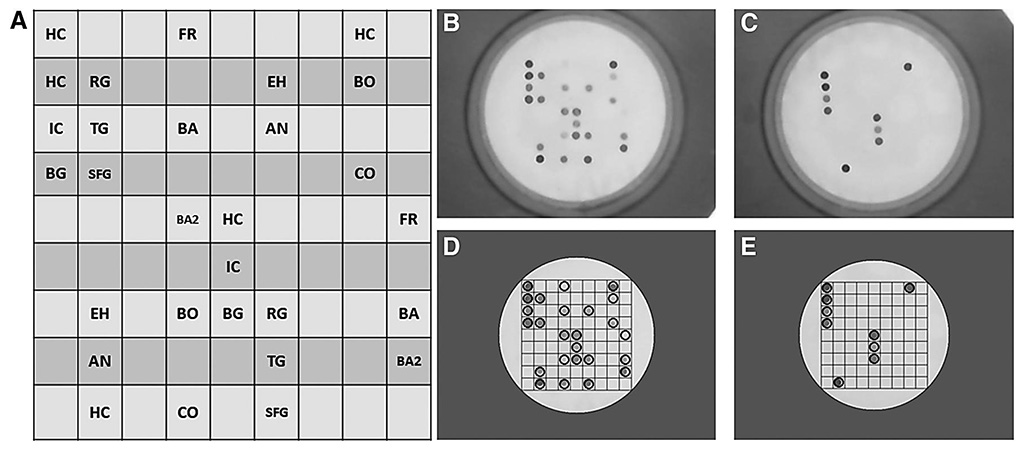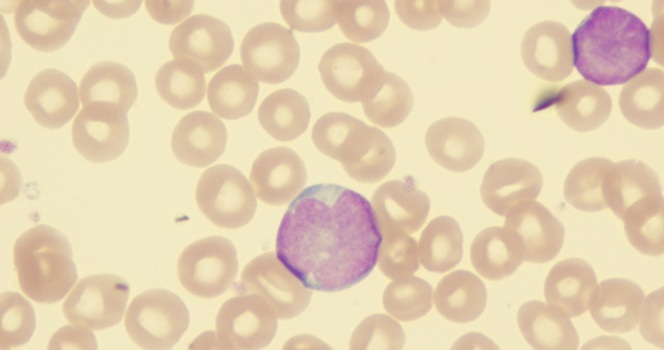Rapid DNA Flow Technology Platform Detects Tick-Borne Bacterial Pathogens
|
By LabMedica International staff writers Posted on 13 Nov 2019 |

Image: Simultaneous detection of Anaplasma spp., Bartonella spp., Borrelia spp., Coxiella burnetii, Francisella spp., and Rickettsia spp. on a tick-borne bacteria flow chip (TBFC) kit (Photo courtesy of Rutgers University).
Ticks are the most important vectors for infectious diseases in the northern hemisphere and second only after mosquitos worldwide. As a result, there is an increasing public health interest in tick-borne pathogens.
Ticks can transmit diseases such as Lyme disease, human granulocytic anaplasmosis, and spotted fever rickettsioses, among others. Therefore, there is a growing need to develop better and faster diagnostic tools that can detect zoonotic human pathogens in clinical samples.
Medical Infectious Disease Scientists from Rutgers University (New Brunswick, NJ, USA) and their international colleagues collected samples from 212 patients who presented a broad range of clinical signs/symptoms consistent with multisystem disorders that could be suggestive of an infection caused by any of the pathogens included in the panel of the tick-borne bacteria flow chip (TBFC) kit. Human DNA was used to spike positive controls came from cerebrospinal fluid (CSF) or biopsies from patients who tested negative to the pathogens included in the testing of the TBFC kit.
The TBFC is intended for the simultaneous qualitative detection of DNA from seven different genera of tick-borne bacteria, Anaplasma, Ehrlichia, Borrelia, Bartonella, Coxiella, Rickettsia, and Francisella, using a multiplex PCR followed by reverse dot blot automatic hybridization into a macroarray CHIP based on DNA-Flow Technology (hybriSpot). The kit offers the amplification of bacterial DNA by two multiplex polymerase chain reactions (PCRs) containing all primers for the specific amplification of the seven bacteria genera and two sets of primers for the amplification of two internal controls.
The scientists reported that the sensitivity of the TBFC was tested for each pathogen independently in the presence of human DNA. Despite human co-infections with tick-borne pathogens being rare, one of the strengths of the TBFC is that it can detect them. To prove that the TBFC detects co-infections, they included positive controls (103–104 plasmid copy/genome equivalents, PC/GE) for each pathogen. The results confirmed that the TBFC could detect all the pathogens simultaneously without compromising its sensitivity.
The TBFC platform offers four significant advantages. First, it is rapid and automatized, significantly shortening the time for the diagnosis of tick-borne pathogens. The TBFC kit gives results in 3.5 hours, while the in-house PCR-reverse line blot takes 8.5 hours for one pathogen. Second, it allows the simultaneous detection of multiple pathogens, which represents an excellent advantage for diseases that display similar symptoms early on. Third, the TBFC can analyze a wide variety of clinical samples with high sensitivity and specificity. Fourth, it is a valuable alternative to serology for early diagnosis.
The authors concluded that the TBFC kit is a rapid and highly sensitive and specific diagnostic tool, capable of simultaneously screening multiple bacterial pathogens. The study was published on October 22, 2019 in the journal Vector-Borne and Zoonotic Diseases.
Related Links:
Rutgers University
Ticks can transmit diseases such as Lyme disease, human granulocytic anaplasmosis, and spotted fever rickettsioses, among others. Therefore, there is a growing need to develop better and faster diagnostic tools that can detect zoonotic human pathogens in clinical samples.
Medical Infectious Disease Scientists from Rutgers University (New Brunswick, NJ, USA) and their international colleagues collected samples from 212 patients who presented a broad range of clinical signs/symptoms consistent with multisystem disorders that could be suggestive of an infection caused by any of the pathogens included in the panel of the tick-borne bacteria flow chip (TBFC) kit. Human DNA was used to spike positive controls came from cerebrospinal fluid (CSF) or biopsies from patients who tested negative to the pathogens included in the testing of the TBFC kit.
The TBFC is intended for the simultaneous qualitative detection of DNA from seven different genera of tick-borne bacteria, Anaplasma, Ehrlichia, Borrelia, Bartonella, Coxiella, Rickettsia, and Francisella, using a multiplex PCR followed by reverse dot blot automatic hybridization into a macroarray CHIP based on DNA-Flow Technology (hybriSpot). The kit offers the amplification of bacterial DNA by two multiplex polymerase chain reactions (PCRs) containing all primers for the specific amplification of the seven bacteria genera and two sets of primers for the amplification of two internal controls.
The scientists reported that the sensitivity of the TBFC was tested for each pathogen independently in the presence of human DNA. Despite human co-infections with tick-borne pathogens being rare, one of the strengths of the TBFC is that it can detect them. To prove that the TBFC detects co-infections, they included positive controls (103–104 plasmid copy/genome equivalents, PC/GE) for each pathogen. The results confirmed that the TBFC could detect all the pathogens simultaneously without compromising its sensitivity.
The TBFC platform offers four significant advantages. First, it is rapid and automatized, significantly shortening the time for the diagnosis of tick-borne pathogens. The TBFC kit gives results in 3.5 hours, while the in-house PCR-reverse line blot takes 8.5 hours for one pathogen. Second, it allows the simultaneous detection of multiple pathogens, which represents an excellent advantage for diseases that display similar symptoms early on. Third, the TBFC can analyze a wide variety of clinical samples with high sensitivity and specificity. Fourth, it is a valuable alternative to serology for early diagnosis.
The authors concluded that the TBFC kit is a rapid and highly sensitive and specific diagnostic tool, capable of simultaneously screening multiple bacterial pathogens. The study was published on October 22, 2019 in the journal Vector-Borne and Zoonotic Diseases.
Related Links:
Rutgers University
Latest Microbiology News
- Rapid Diagnostic Test Matches Gold Standard for Sepsis Detection
- Rapid POC Tuberculosis Test Provides Results Within 15 Minutes
- Rapid Assay Identifies Bloodstream Infection Pathogens Directly from Patient Samples
- Blood-Based Molecular Signatures to Enable Rapid EPTB Diagnosis
- 15-Minute Blood Test Diagnoses Life-Threatening Infections in Children
- High-Throughput Enteric Panels Detect Multiple GI Bacterial Infections from Single Stool Swab Sample
- Fast Noninvasive Bedside Test Uses Sugar Fingerprint to Detect Fungal Infections
- Rapid Sepsis Diagnostic Device to Enable Personalized Critical Care for ICU Patients
- Microfluidic Platform Assesses Neutrophil Function in Sepsis Patients
- New Diagnostic Method Confirms Sepsis Infections Earlier
- New Markers Could Predict Risk of Severe Chlamydia Infection
- Portable Spectroscopy Rapidly and Noninvasively Detects Bacterial Species in Vaginal Fluid
- CRISPR-Based Saliva Test Detects Tuberculosis Directly from Sputum
- Urine-Based Assay Diagnoses Common Lung Infection in Immunocompromised People
- Saliva Test Detects Implant-Related Microbial Risks
- New Platform Leverages AI and Quantum Computing to Predict Salmonella Antimicrobial Resistance
Channels
Clinical Chemistry
view channel
Chemical Imaging Probe Could Track and Treat Prostate Cancer
Prostate cancer remains a leading cause of illness and death among men, with many patients eventually developing resistance to standard hormone-blocking therapies. These drugs often lose effectiveness... Read more
Mismatch Between Two Common Kidney Function Tests Indicates Serious Health Problems
Creatinine has long been the standard for measuring kidney filtration, while cystatin C — a protein produced by all human cells — has been recommended as a complementary marker because it is influenced... Read moreMolecular Diagnostics
view channel
Simple Urine Test to Revolutionize Bladder Cancer Diagnosis and Treatment
Bladder cancer is one of the most common and deadly urological cancers and is marked by a high rate of recurrence. Diagnosis and follow-up still rely heavily on invasive cystoscopy or urine cytology, which... Read more
Blood Test to Enable Earlier and Simpler Detection of Liver Fibrosis
Persistent liver damage caused by alcohol misuse or viral infections can trigger liver fibrosis, a condition in which healthy tissue is gradually replaced by collagen fibers. Even after successful treatment... Read moreHematology
view channel
Platelet Activity Blood Test in Middle Age Could Identify Early Alzheimer’s Risk
Early detection of Alzheimer’s disease remains one of the biggest unmet needs in neurology, particularly because the biological changes underlying the disorder begin decades before memory symptoms appear.... Read more
Microvesicles Measurement Could Detect Vascular Injury in Sickle Cell Disease Patients
Assessing disease severity in sickle cell disease (SCD) remains challenging, especially when trying to predict hemolysis, vascular injury, and risk of complications such as vaso-occlusive crises.... Read more
ADLM’s New Coagulation Testing Guidance to Improve Care for Patients on Blood Thinners
Direct oral anticoagulants (DOACs) are one of the most common types of blood thinners. Patients take them to prevent a host of complications that could arise from blood clotting, including stroke, deep... Read moreImmunology
view channel
New Test Distinguishes Vaccine-Induced False Positives from Active HIV Infection
Since HIV was identified in 1983, more than 91 million people have contracted the virus, and over 44 million have died from related causes. Today, nearly 40 million individuals worldwide live with HIV-1,... Read more
Gene Signature Test Predicts Response to Key Breast Cancer Treatment
DK4/6 inhibitors paired with hormone therapy have become a cornerstone treatment for advanced HR+/HER2– breast cancer, slowing tumor growth by blocking key proteins that drive cell division.... Read more
Chip Captures Cancer Cells from Blood to Help Select Right Breast Cancer Treatment
Ductal carcinoma in situ (DCIS) accounts for about a quarter of all breast cancer cases and generally carries a good prognosis. This non-invasive form of the disease may or may not become life-threatening.... Read morePathology
view channel
Tunable Cell-Sorting Device Holds Potential for Multiple Biomedical Applications
Isolating rare cancer cells from blood is essential for diagnosing metastasis and guiding treatment decisions, but remains technically challenging. Many existing techniques struggle to balance accuracy,... Read moreAI Tool Outperforms Doctors in Spotting Blood Cell Abnormalities
Diagnosing blood disorders depends on recognizing subtle abnormalities in cell size, shape, and structure, yet this process is slow, subjective, and requires years of expert training. Even specialists... Read moreTechnology
view channel
Artificial Intelligence Model Could Accelerate Rare Disease Diagnosis
Identifying which genetic variants actually cause disease remains one of the biggest challenges in genomic medicine. Each person carries tens of thousands of DNA changes, yet only a few meaningfully alter... Read more
AI Saliva Sensor Enables Early Detection of Head and Neck Cancer
Early detection of head and neck cancer remains difficult because the disease produces few or no symptoms in its earliest stages, and lesions often lie deep within the head or neck, where biopsy or endoscopy... Read moreIndustry
view channel
Abbott Acquires Cancer-Screening Company Exact Sciences
Abbott (Abbott Park, IL, USA) has entered into a definitive agreement to acquire Exact Sciences (Madison, WI, USA), enabling it to enter and lead in fast-growing cancer diagnostics segments.... Read more























